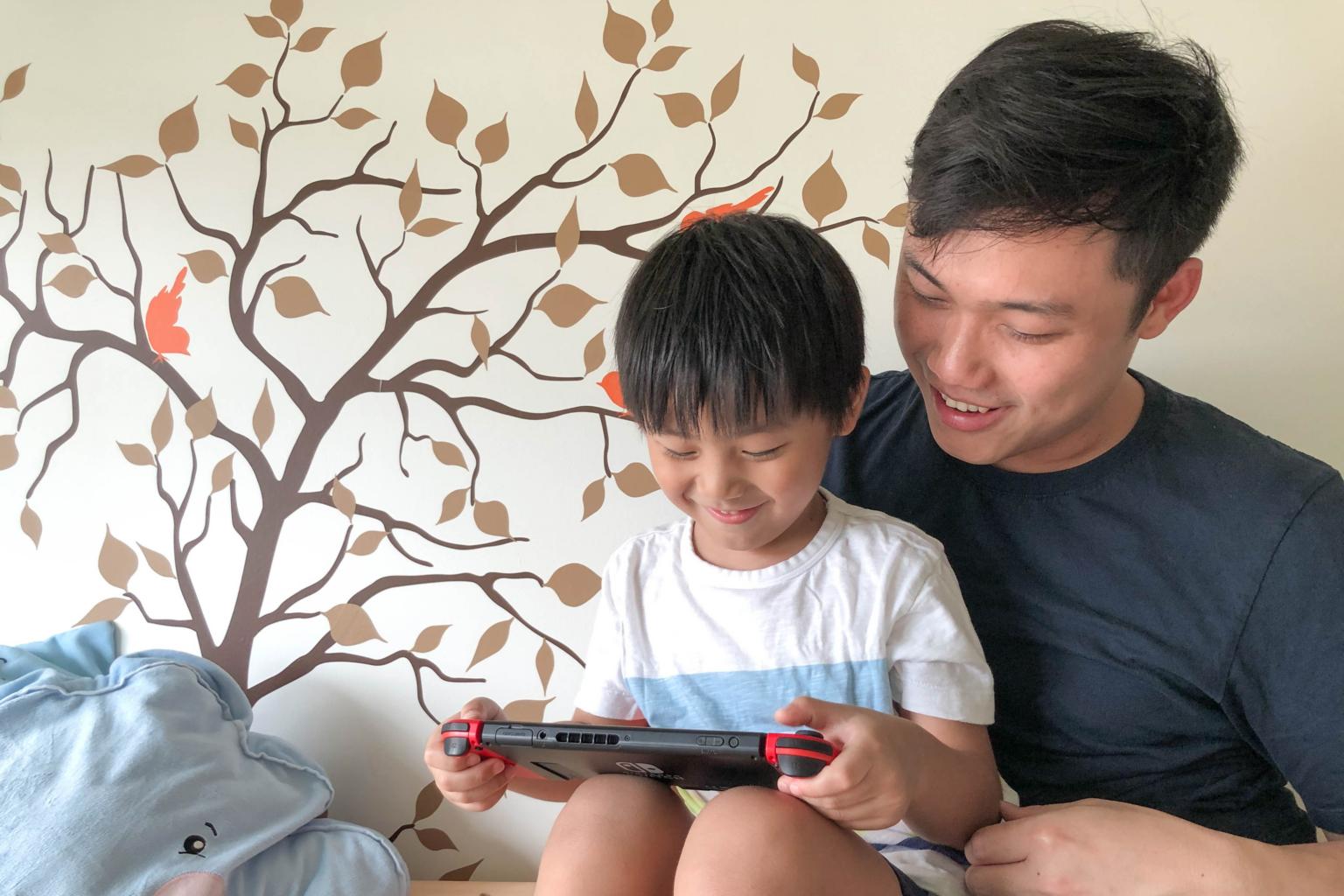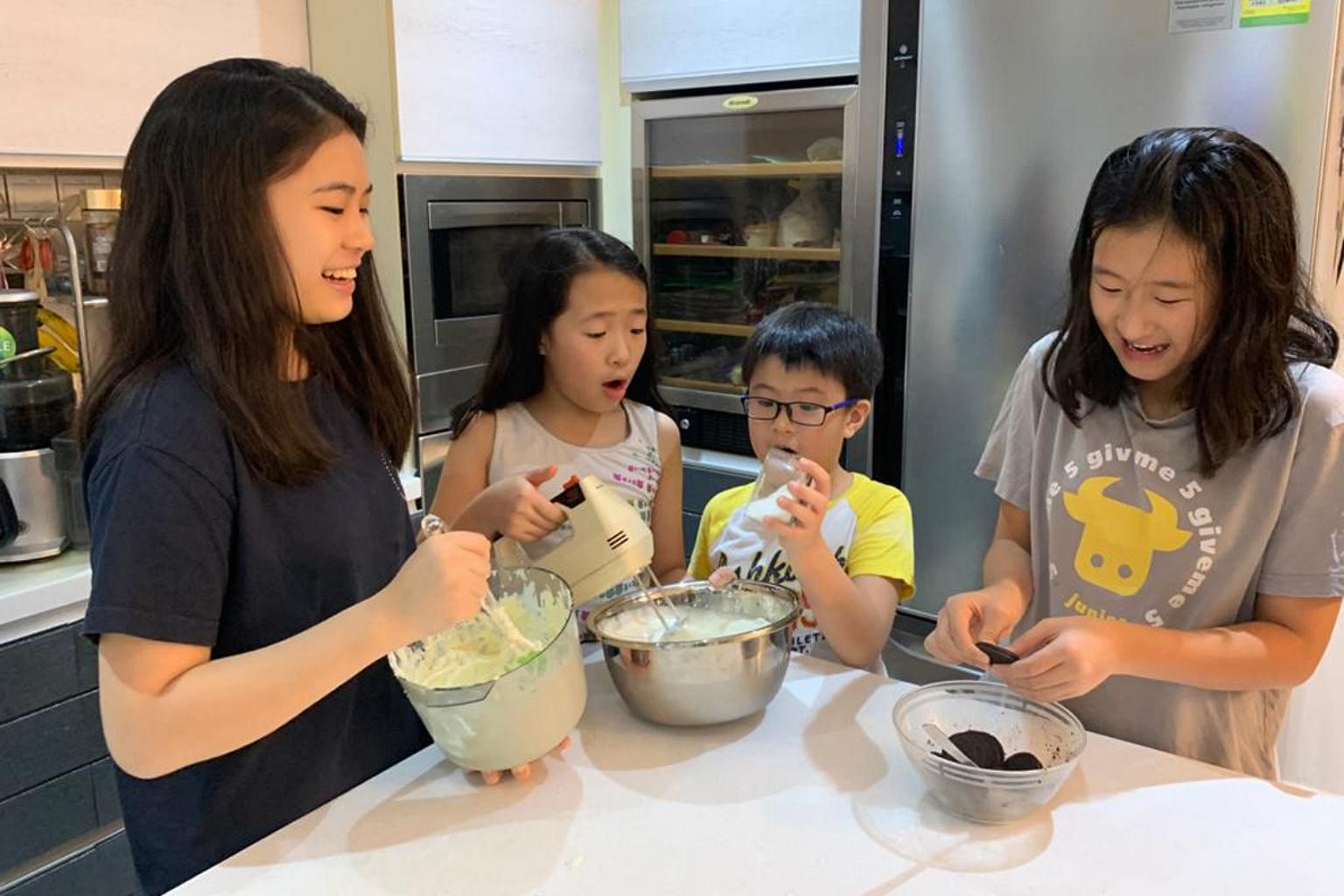The no-guilt guide to screen time for kids during Covid-19
Sign up now: Get ST's newsletters delivered to your inbox

Faculty Early Career Award Fellow at the Singapore University of Technology and Design Andrew Yee (right) with his son, Noah.
PHOTO: COURTESY OF DR ANDREW YEE
Follow topic:
SINGAPORE - When the circuit breaker measures were announced almost a month ago, Dr Andrew Yee quickly drew up a home-based learning timetable for his four-year-old son.
He factored in daily sessions for television and video games, as well as an hour of free play, where Noah can choose anything he wants, including screen-based media.
"This, combined with screen-based learning that his pre-school is administering, means that he is getting quite a bit more screen time than usual," says Dr Yee, a Faculty Early Career Award Fellow at the Singapore University of Technology and Design (SUTD).
His experience echoes that of parents across the world, who have found that the ongoing battle to limit screen time is almost futile now that the whole family has to study, work and entertain themselves at home during the Covid-19 pandemic.
Pre-coronavirus recommended screen-time limits make little sense now. Instead, experts suggest going for quality screen time, mixing things up with creative alternatives to screens and involving children in discussions on the issue.
Assistant professor Dr Jiow Hee Jhee, programme director of the BSc (Hons) Digital Communications and Integrated Media programme at the Singapore Institute of Technology, and a member of the Media Literacy Council, notes: "Basically, all the social or formal interactions that children have with people, pre-circuit breaker, a large percentage of it will be replaced, to some measure, via online means - which would mean a huge increase in screen time."
In Singapore, parents are also scratching their heads wondering how to occupy their children at home without screens during the month-long mid-year school holidays, which now start on Tuesday.
In 2018, the American Academy of Pediatrics (AAP) had recommended no screen time for toddlers below 18 months - except for video chats with, say, grandma. Parents should co-watch with tots aged 18 to 24 months, and allow up to one hour of "high quality programming" for kids aged two to five, ideally with parental engagement, it had said.
The World Health Organization (WHO) also issued similar guidelines for the under-five set last year, including zero "sedentary screen time" for newborns and babies aged up to one year old, and no more than an hour for children aged two to four.
"Less is better", its report had said.
Acknowledging the exceptional circumstances now, the AAP issued this statement on March 17: "While limits are still important, under these stressful circumstances, kids' screen media use will likely increase. Parents can take steps to ensure that this media use is positive and helps the family and community."
It did not prescribe new limits and for good reason.
"We are trying to prevent parents from feeling like they are not meeting some sort of standard," Dr Jenny Radesky, who contributed her expertise to the statement, told The New York Times.
"There is no science behind this right now. If you are looking for specific time limits, then I would say: Don't be on it all day," adds the paediatrician and expert on children and media at the University of Michigan's C.S. Mott Children's Hospital.
Dr Yee, who does research into how social and technological environments affect the health and well-being of youth, also takes a pragmatic approach.
"Media content can be very educational when it is developmentally appropriate for young children," he explains.
When parents watch TV or educational videos on YouTube with their children, they can help bridge knowledge gaps. For example, if their child does not know what evaporation means, they can pause the show and take them into the kitchen to demonstrate by boiling water.
But with many parents still working from home during the school holidays, watching and learning together with their kids is not always possible.
In such cases, Dr Yee suggests that they choose content that meets the "educational sweet spot" - it should not be too difficult or too easy for the child and it should help them gain knowledge.
Mums and dads should check in occasionally and ask what is happening on screen.
"When children respond, they have to cognitively process the information on screen and articulate it to their parents," he says.
In this way, parents can tell if the programme or game is truly beneficial and look for alternatives if necessary.
Curating content also means culling undesirable videos or games, which parents can get their little ones involved in, too.
"For example, when I banned Ryan Toys Review on the YouTube Kids application, I explained to him that it is essentially advertising aimed at getting children to want to buy toys they don't need," Dr Yee says.
"Over time, he understood the concept of advertising, and would sometimes point out advertisements and how we should turn it off or skip it."
Limiting screen use for schoolgoing children is more challenging, as much of home-based learning is done online, says Professor Lim Sun Sun, head of the humanities, arts and social sciences department at SUTD and a Nominated Member of Parliament.
In addition, students in secondary and tertiary institutions had to rely on devices for learning and other school-related projects even before the pandemic hit.
"We also have to also be a little bit understanding of the fact that because they don't see their classmates, that they miss them, and they still want to maintain that social interaction," she says.
It boils down to the "nature and quality of use", she adds. For instance, it would not make sense to lock up the laptop of a child who spends time honing his or her skills in coding and programming.
Beyond teaching children to take vision breaks every 20 to 30 minutes for health reasons, Prof Jiow advocates finding creative alternatives to recreational screen time.
His 12-year-old daughter, Gayle, calls friends instead of sending WhatsApp messages where possible, while 14-year-old Genevieve does sit-ups as a device time-out throughout the day. The father of four kids aged nine to 16 also enjoys baking with his brood almost daily.

When power struggles over screen use erupt, it is easy for parents to blame gadgets and see them as an "enemy" rather than a tool with educational potential. So, setting limits should be done with the unhealthy behaviour in mind.
Dr Yee says: "Are parents worried about media affecting children's sleep? If so, they can negotiate to not use media devices one hour before bedtime. Are parents worried about exercise? If so, they can allow media consumption only once they finish some sort of physical activity. Finally, are parents worried about it affecting grades? If so, media use can be negotiated to be something that is allowed only after their school assignments."
Mr Kelvin Ang, 43, is one parent who seems to have found a win-win solution for his three kids, aged nine to 15.
"I place equal emphasis on consumption and creation. They can consume by playing their favourite games on the iPad for one or two hours, but in return, they must also create something for one or two hours," says the financial planner who is behind the popular Cheekiemonkies parenting and lifestyle blog.
This means that if his children play on the Nintendo Switch for an hour, they will spend the next hour creating videos on an iPad, or making slime after watching an instructional YouTube video, for example.
"As they grew older, I realised that they started picking up extra skills - skills that are not normally taught in classrooms. Ayden's Excel skills have now surpassed mine, while Alethea has picked up video editing and anime drawing skills."
4 SIGNS OF QUALITY CONTENT FOR PRE-SCHOOLERS
Young children benefit most when their parents engage them during screen time, say the experts at the National Institute of Early Childhood Development. Set up by the Ministry of Education, it trains early childhood educators.
Avoid devices before bedtime and read books instead, they add. When looking for high-quality media content, ask yourself:
Is it engaging: Do the design features keep your child focused or distracted from the learning goal?
Does it actively involve: Do the tasks challenge your kid to explore or does your child tap and swipe mindlessly?
Is it meaningful: Does the content introduce new concepts within a context your child is familiar with?
Can it be social: Can you engage with your child by using "serve-and-return interactions" like talking about what he or she sees and does?

